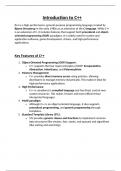International Trade
BA Course
UCL, SSEES
Lecture 4: The Heckscher-Ohlin Model
Idil Uz Akdogan
,Introduction
1) Ricardo’s model:
• Labour is the only input of production.
• Comparative advantage results from labour productivity gaps.
• Trade enlarges both production and consumption frontiers.
2) Samuelson and Jones (SF model):
• Three inputs: Labour can move across industries, while Capital and Land are sector-s
• Trade results from country differences in resources abundance and relative intensity
• The specific factor model sheds light on the distribution of gains from trade between L
Capital, and Land.
3) Heckscher and Ohlin (HO model):
• Two inputs, both are mobile across sectors.
• Trade results from country differences in resources abundance and relative intensity o
(comparative advantage).
• HO’s factor-proportions model emphasizes the relationship between relative resource
availability and intensity, and trade.
, The Model’s Assumptions
1. Two countries: Home and Foreign.
2. Two goods: Cloth (C) and Food (F)
3. Two factors of production - Labour (L) and Capital (K) – are
substitutes and can be moved across sectors.
Unit Factor requirements in each sector:
4. While cloth production is labour-intensive, food is capital-intens
5. Countries have identical production technologies and consu
preferences but different endowments of resources.
6. The supply of Labour and Capital in each country is constant bu
across countries.
, Production Possibility Frontier
• With more than one factor of production, the opportunity cost in
production is no longer constant and the PPF is no longer a stra
line. Why?
• Numerical example:
K = 3000, total amount of capital available for production
L = 2000, total amount of labour available for production
• Suppose use a fixed mix of capital and labour in each sector.
aKC = 2, capital used to produce one yard of cloth
aLC = 2, labour used to produce one yard of cloth
aKF = 3, capital used to produce one calorie of food
aLF = 1, labour used to produce one calorie of food
BA Course
UCL, SSEES
Lecture 4: The Heckscher-Ohlin Model
Idil Uz Akdogan
,Introduction
1) Ricardo’s model:
• Labour is the only input of production.
• Comparative advantage results from labour productivity gaps.
• Trade enlarges both production and consumption frontiers.
2) Samuelson and Jones (SF model):
• Three inputs: Labour can move across industries, while Capital and Land are sector-s
• Trade results from country differences in resources abundance and relative intensity
• The specific factor model sheds light on the distribution of gains from trade between L
Capital, and Land.
3) Heckscher and Ohlin (HO model):
• Two inputs, both are mobile across sectors.
• Trade results from country differences in resources abundance and relative intensity o
(comparative advantage).
• HO’s factor-proportions model emphasizes the relationship between relative resource
availability and intensity, and trade.
, The Model’s Assumptions
1. Two countries: Home and Foreign.
2. Two goods: Cloth (C) and Food (F)
3. Two factors of production - Labour (L) and Capital (K) – are
substitutes and can be moved across sectors.
Unit Factor requirements in each sector:
4. While cloth production is labour-intensive, food is capital-intens
5. Countries have identical production technologies and consu
preferences but different endowments of resources.
6. The supply of Labour and Capital in each country is constant bu
across countries.
, Production Possibility Frontier
• With more than one factor of production, the opportunity cost in
production is no longer constant and the PPF is no longer a stra
line. Why?
• Numerical example:
K = 3000, total amount of capital available for production
L = 2000, total amount of labour available for production
• Suppose use a fixed mix of capital and labour in each sector.
aKC = 2, capital used to produce one yard of cloth
aLC = 2, labour used to produce one yard of cloth
aKF = 3, capital used to produce one calorie of food
aLF = 1, labour used to produce one calorie of food



